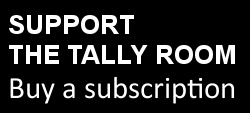A few months ago I published a limited data repository, containing booth lists, candidate lists and election results at the booth level for a variety of state and local elections. At the time I talked about how most state electoral commissions fell short of the AEC when it comes to publishing complete and easy-to-use election datasets.
I’ve been most frustrated by the Tasmanian Electoral Commission, on two fronts. Firstly, they publish the booth-level vote data in a very unfriendly manner: upper house results are published as PNG image files. Lower house primary votes are published as PDF files, and distributions of preferences as image files. The image files look very nice, unless you want to copy them into a spreadsheet and perform deeper analysis.
Secondly, the TEC is terrible at publishing booth lists which can be matched to the results. They publish a list of premises used for each election, including the suburb, but often there are more than one booth in a suburb. The results data contains a unique booth name, but for at least a decade now the TEC has rarely if ever published the booth data in the correct format allowing the matching of those addresses to the actual vote data.
For three years from 2013 to 2015 I published guides to the Tasmanian upper house elections, which are held every May for a small part of the state. This included the tedious task of tracking down the complete data to match addresses to vote data. I’ve decided to finish this task, and have been able to put together a booth list with unique booth names for the last ten years of upper house elections from 2007 to 2016. This can then be matched to the vote data at the booth level. The booth list also includes latitude and longitude for every ordinary booth.
 It’s taken some time to pull together the data, but I’ve now got a complete set of booth-level data from the 2012 and 2016 local council elections.
It’s taken some time to pull together the data, but I’ve now got a complete set of booth-level data from the 2012 and 2016 local council elections.